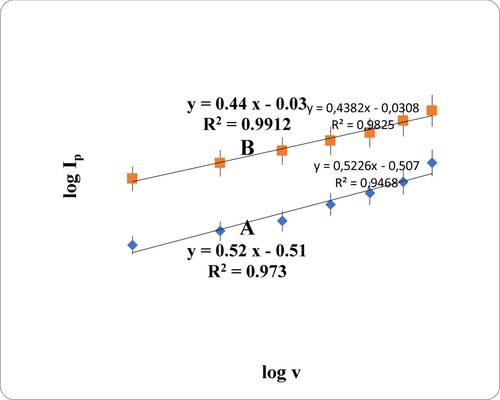当前位置:
X-MOL 学术
›
Electroanalysis
›
论文详情
Our official English website, www.x-mol.net, welcomes your feedback! (Note: you will need to create a separate account there.)
An Efficient Novel Electrochemical Sensor for Simultaneous Determination of Vitamin C and Aspirin Based on a PMR/Zn-Al LDH/GCE
Electroanalysis ( IF 3 ) Pub Date : 2021-09-09 , DOI: 10.1002/elan.202100151 Ahmed Abo-bakr 1 , Mohamed Abd-Elsabour 1 , Mortaga Abou-Krisha 1
Electroanalysis ( IF 3 ) Pub Date : 2021-09-09 , DOI: 10.1002/elan.202100151 Ahmed Abo-bakr 1 , Mohamed Abd-Elsabour 1 , Mortaga Abou-Krisha 1
Affiliation

|
A sensitive, low-cost, and simple electrochemical sensor based on Zn−Al layered double hydroxide (Zn−Al LDH) combined with a polymer film of methyl red (PMR) to modify a GCE has been created for the first time. Using cyclic voltammetry (CV), the electrochemical characteristics of the newly fabricated sensor were investigated. The characterised PMR/Zn−Al LDH/GCE shows high electro-catalytic activity towards the vitamin C (AA) and aspirin (ASA) oxidation. Schematic fabrication of PMR/Zn−Al LDH/GCE for the determination of AA or ASA was presented. The new sensor demonstrated superior analytical efficiency for the simultaneous identification of AA and ASA traces in well-spaced anodic peaks, even in the presence of certain intervening species. According to experimental results, the fabricated sensor represented two well-separated oxidation peaks for AA and ASA oxidation with potential difference of 799 mV (vs. Ag/AgCl). The linear dependences of the anodic peak currents of AA and ASA on their concentrations in the ranges of 0.10–53.17 μM are good. The detection limits of AA and ASA at the PMR/Zn−Al LDH/GCE were found to be 1.26 and 1.27 μM, respectively. Meanwhile, the quantification limits of AA and ASA were calculated as 4.21 and 4.25 μM, respectively. On other hand, the limit of detection (LODs) of AA and ASA oxidation were determined to be 0.47 and 0.21 μM, respectively, according to DPV method. The effect of scan rate (100 to 800 mV/s) on the anodic peak currents of AA and ASA was examined. A sensing model mechanism has been suggested and discussed in detail. Finally, the proposed sensor displayed a good reproducibility, stability and selectivity. The developed sensor was eventually used to successfully detect AA and ASA in urine samples.
中文翻译:

基于PMR/Zn-Al LDH/GCE的同时测定维生素C和阿司匹林的高效新型电化学传感器
首次创建了一种基于 Zn-Al 层状双氢氧化物 (Zn-Al LDH) 与甲基红 (PMR) 聚合物膜相结合以修饰 GCE 的灵敏、低成本且简单的电化学传感器。使用循环伏安法 (CV),研究了新制造的传感器的电化学特性。表征的 PMR/Zn-Al LDH/GCE 对维生素 C (AA) 和阿司匹林 (ASA) 氧化显示出高电催化活性。提出了用于测定 AA 或 ASA 的 PMR/Zn-Al LDH/GCE 的示意图。新传感器显示出卓越的分析效率,即使在存在某些中间物质的情况下,也能同时识别间隔良好的阳极峰中的 AA 和 ASA 痕量。根据实验结果,制造的传感器代表 AA 和 ASA 氧化的两个分离良好的氧化峰,电位差为 799 mV(相对于 Ag/AgCl)。AA 和 ASA 的阳极峰值电流与其浓度在 0.10–53.17 μM 范围内的线性相关性很好。AA 和 ASA 在 PMR/Zn-Al LDH/GCE 的检测限分别为 1.26 和 1.27 μM。同时,计算出的 AA 和 ASA 的定量限分别为 4.21 和 4.25 μM。另一方面,根据 DPV 方法,AA 和 ASA 氧化的检测限 (LOD) 分别确定为 0.47 和 0.21 μM。检查了扫描速率(100 到 800 mV/s)对 AA 和 ASA 的阳极峰值电流的影响。已经提出并详细讨论了一种传感模型机制。最后,所提出的传感器显示出良好的重现性、稳定性和选择性。开发的传感器最终用于成功检测尿样中的 AA 和 ASA。
更新日期:2021-09-09
中文翻译:

基于PMR/Zn-Al LDH/GCE的同时测定维生素C和阿司匹林的高效新型电化学传感器
首次创建了一种基于 Zn-Al 层状双氢氧化物 (Zn-Al LDH) 与甲基红 (PMR) 聚合物膜相结合以修饰 GCE 的灵敏、低成本且简单的电化学传感器。使用循环伏安法 (CV),研究了新制造的传感器的电化学特性。表征的 PMR/Zn-Al LDH/GCE 对维生素 C (AA) 和阿司匹林 (ASA) 氧化显示出高电催化活性。提出了用于测定 AA 或 ASA 的 PMR/Zn-Al LDH/GCE 的示意图。新传感器显示出卓越的分析效率,即使在存在某些中间物质的情况下,也能同时识别间隔良好的阳极峰中的 AA 和 ASA 痕量。根据实验结果,制造的传感器代表 AA 和 ASA 氧化的两个分离良好的氧化峰,电位差为 799 mV(相对于 Ag/AgCl)。AA 和 ASA 的阳极峰值电流与其浓度在 0.10–53.17 μM 范围内的线性相关性很好。AA 和 ASA 在 PMR/Zn-Al LDH/GCE 的检测限分别为 1.26 和 1.27 μM。同时,计算出的 AA 和 ASA 的定量限分别为 4.21 和 4.25 μM。另一方面,根据 DPV 方法,AA 和 ASA 氧化的检测限 (LOD) 分别确定为 0.47 和 0.21 μM。检查了扫描速率(100 到 800 mV/s)对 AA 和 ASA 的阳极峰值电流的影响。已经提出并详细讨论了一种传感模型机制。最后,所提出的传感器显示出良好的重现性、稳定性和选择性。开发的传感器最终用于成功检测尿样中的 AA 和 ASA。



























 京公网安备 11010802027423号
京公网安备 11010802027423号